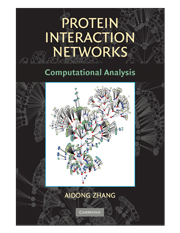Book contents
- Frontmatter
- Contents
- Preface
- 1 Introduction
- 2 Experimental Approaches to Generation of PPI Data
- 3 Computational Methods for the Prediction of PPIs
- 4 Basic Properties and Measurements of Protein Interaction Networks
- 5 Modularity Analysis of Protein Interaction Networks
- 6 Topological Analysis of Protein Interaction Networks
- 7 Distance-Based Modularity Analysis
- 8 Graph-Theoretic Approaches to Modularity Analysis
- 9 Flow-Based Analysis of Protein Interaction Networks
- 10 Statistics and Machine Learning Based Analysis of Protein Interaction Networks
- 11 Integration of GO into the Analysis of Protein Interaction Networks
- 12 Data Fusion in the Analysis of Protein Interaction Networks
- 13 Conclusion
- Bibliography
- Index
13 - Conclusion
Published online by Cambridge University Press: 28 January 2010
- Frontmatter
- Contents
- Preface
- 1 Introduction
- 2 Experimental Approaches to Generation of PPI Data
- 3 Computational Methods for the Prediction of PPIs
- 4 Basic Properties and Measurements of Protein Interaction Networks
- 5 Modularity Analysis of Protein Interaction Networks
- 6 Topological Analysis of Protein Interaction Networks
- 7 Distance-Based Modularity Analysis
- 8 Graph-Theoretic Approaches to Modularity Analysis
- 9 Flow-Based Analysis of Protein Interaction Networks
- 10 Statistics and Machine Learning Based Analysis of Protein Interaction Networks
- 11 Integration of GO into the Analysis of Protein Interaction Networks
- 12 Data Fusion in the Analysis of Protein Interaction Networks
- 13 Conclusion
- Bibliography
- Index
Summary
The generation of protein-protein interaction (PPI) data is proceeding at a rapid and accelerating pace, heightening the demand for advances in the computational methods used to analyze patterns and relationships in these complex data sets. This book has offered a systematic presentation of a variety of advanced computational approaches that are available for the analysis of PPI networks. In particular, we have focused on those approaches that address the modularity analysis and functional prediction of proteins in PPI networks. These computational techniques have been presented as belonging to seven categories:
Basic representation and modularity analysis. Throughout this book, PPI networks have been represented through mathematical graphs, and we have provided a detailed discussion of the basic properties of such graphs. PPI networks have been identified as modular and hierarchical in nature, and modularity analysis is therefore of particular utility in understanding their structure. A range of approaches has been proposed for the detection of modules within these networks and to guide the prediction of protein function. We have broadly classified these methods as distance-based, graph-theoretic, topology-based, flow-based, statistical, and domain knowledge-based. Clustering a PPI network permits a better understanding of its structure and the interrelationship of its constituent components. The potential functions of unannotated proteins may be predicted by comparison with other members of the same functional module.
Distance-based analysis. Chapter 7 surveyed five categories of approaches to distance-based clustering. All these methods use classic clustering techniques and focus on the definition of the topological or biological distance or similarity between two proteins in a network.
[…]
- Type
- Chapter
- Information
- Protein Interaction NetworksComputational Analysis, pp. 251 - 254Publisher: Cambridge University PressPrint publication year: 2009



